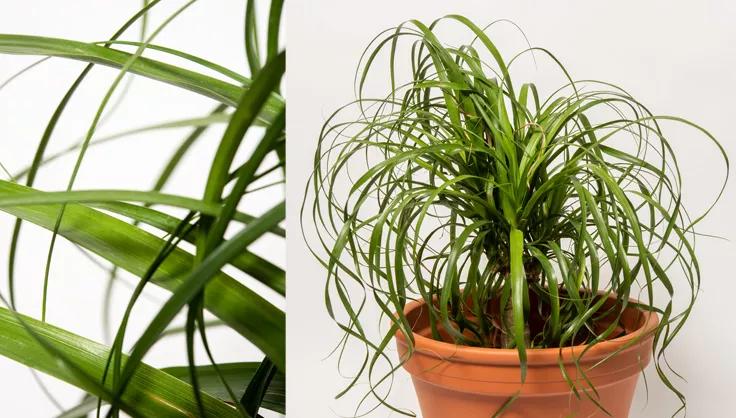How to Grow & Care for a Ponytail Palm

Cultivars/Types of Ponytail Palm to Try
B. recurvata ‘Gold Star’ features narrow green leaves with pale yellow margins; B. recurvata ‘Glauca’ boasts blue-tinged leaves
Best Growing Conditions for Ponytail Palms
Light
Ponytail palms prefer to have as much light as possible, so place the plant in a bright location. Full sun or bright indirect light is best.
Soil
Ponytail palms need a grainy, well-drained soil; a premade cactus mix or a homemade blend of sand, perlite, and standard potting mix will help replicate its native desert ground. The soil should be slightly acidic, with a pH of 6.5 to 7.5.
Humidity
Ponytail palms grow happily in average humidity and do not need any special care in this regard. As desert natives, they even tolerate the dry, warm air that results from indoor heating.
How to Care for Ponytail Palms
Watering
In nature, the plants would receive rainfall in the summer and remain dry through most of the winter — try to mimic this watering schedule for container-grown plants. Ponytail palms need to be watered infrequently, as they are prone to overwatering. Allow the top inch or two of soil to dry out completely before re-watering. The ponytail palm has a woody trunk that flares out to a bulbous base that stores water during drought periods, similar to a camel’s hump. Overwatering is just about the only mistake you can make with this hardy houseplant.
Fertilizing
Ponytail palms do not need much fertilizer, as they are slow-growing and have low nutrient requirements. A balanced fertilizer diluted to half-strength can be applied once or twice during the growing season. Fertilizer should be avoided during the winter when the plant is dormant.
Pruning
Pruning a ponytail palm is not typically necessary. However, you can trim off any brown leaf tips or dead leaves using clean, sharp scissors or pruning shears. Pruning can be done at any time of the year, but it is best to avoid pruning during the winter.
Repotting
These plants prefer to be slightly root-bound, so repotting isn’t a frequent necessity. When you do repot, choose a container only slightly larger than the previous one. As always, be sure your replacement container has adequate drainage at the bottom!
Propagating
Ponytail palms are easy to propagate. Ponytail palms can be propagated from offsets or “pups” that grow at the base of the plant. Using a clean knife or pruning shears, gently separate these pups from the mother plant and pot them individually. Pups that are at least 4 inches (10 cm) tall make the best starts as they have started to form a root base. Place the rooted end of the pup in a moistened growing medium in a well-draining container. Place the container in a warm room in moderate light and care for it just as you would a mature plant.
Ponytail Palm Pests and Problems
Notable Pests: Ponytail palms are generally pest-free, but mealybugs or scale can occasionally be a problem.
Notable Diseases: Ponytail palms are susceptible to root rot or stem rot, caused by overwatering or poor drainage. These diseases can be prevented by watering sparingly, using well-draining soil, and avoiding wetting the leaves. Other diseases that can affect ponytail palms include leaf spot, powdery mildew, or ring spot virus. These diseases can be treated by removing the infected parts, improving air circulation, and applying fungicides if necessary.
Signs of Stress
Ponytail palms can show signs of stress due to pooor growing conditions. Some common signs of stress are:
Mushy trunks: This can indicate overwatering or root rot. The plant should be checked for soggy soil and repotted in fresh soil if needed. The watering frequency should be reduced and the drainage should be improved.
Curling or brown edges on leaves: This can indicate low humidity or sunburn. The plant should be moved away from direct sunlight and placed in a more humid environment.
Pale or faded leaves: This can indicate insufficient light or nutrient deficiency. The plant should be moved to a brighter location and fertilized with a balanced fertilizer.
Ponytail Palm FAQs
Q: Why is my ponytail palm dropping leaves?
A: Leaf drop can occur due to overwatering, shock from repotting, or a significant change in lighting or temperature. Assess the care you're providing and adjust as necessary.
Q: Can ponytail palms be grown outdoors?
A: In warmer climates (USDA zones 9-11), ponytail palms can be grown outdoors; they are not tolerant of freezing temperatures. They need to be acclimated slowly to outdoor conditions. Try planting your ponytail palm in a container and setting it out on a protected patio or porch — it can be easily moved indoors if temperatures plummet.
Q: How fast do ponytail palms grow?
A: Ponytail palms are slow-growing plants, especially when grown indoors. Expect moderate growth in the right conditions, but patience is key with these plants.
Hardy, nontoxic to people and pets, and rocking a distinctive silhouette, the ponytail palm is an essential addition to your indoor plant garden!
Print this Article:
Get the Dirt
Stay up to date on new articles and advice. Please fill out the information below.
